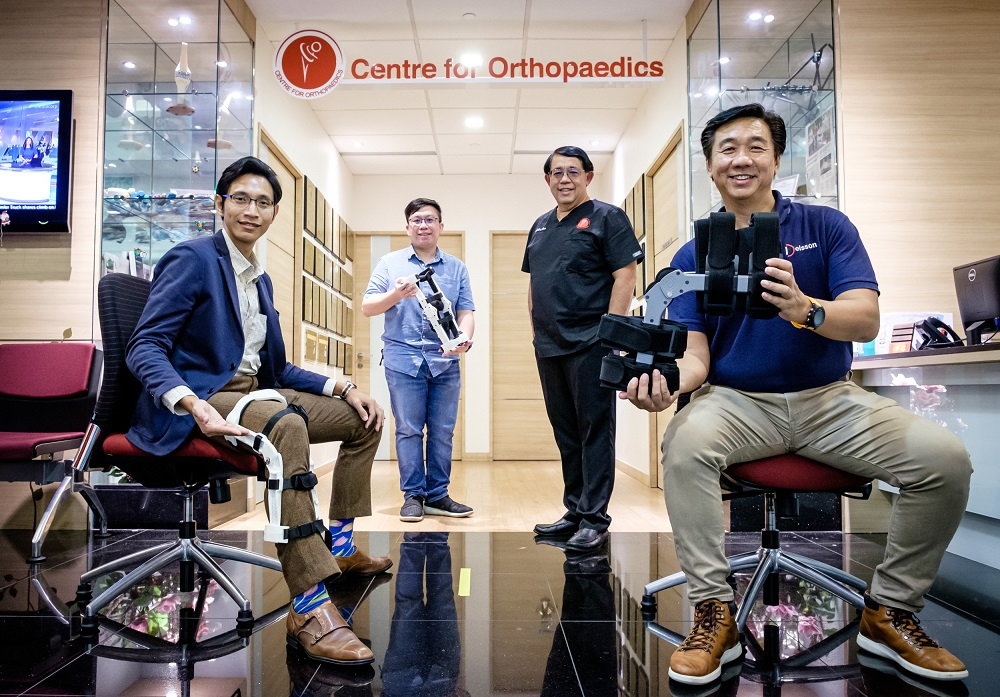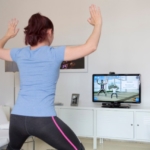3D printing leads to light-weight knee brace for the elderly
A lighter, yet more robust knee brace for the elderly who suffer from knee problems has been developed locally by Singapore engineering firm Delsson, in a collaboration with 3D printing specialists from Nanyang Technological University, Singapore (NTU Singapore).

(Left to right) NTU Asst Prof Chan Wai Lee wearing the 3D-printed prototype knee brace, PhD student Joel Lim holding the prototype, Centre for Orthopaedics Chairman & CEO Dr Jeffery Chew, and Delsson Executive Director Fabian Ong holding the commercial X-Brace sold on the market. NTU Singapore
Lester Kok, Nanyang Technological University via EurekAlert! AAAS 15 December 2021
Using 3D printing techniques – also known as additive manufacturing – the team has managed to reduce the weight of a traditional exoskeleton knee brace, typically built using metal, by 30 percent, thanks to a new design that uses lightweight plastic and assistive springs.
Knee pain is a common problem around the world for people over 65, with an estimated one-third of the United States population reported suffering from knee pain at some time or another.[1] In 2017, 20 percent of the elderly in Singapore aged 60 and above suffer from chronic pain.[2]
Braces are usually prescribed to the elderly patients to help alleviate the burden on their knee joints, as well as to assist patients who have undergone surgery on their knees, such as reconstruction of torn ligaments, often suffered by athletes.
Based on the prototype assistive orthopaedic brace 3D-printed by NTU researchers, Delsson and the Centre for Orthopaedics in Singapore have developed a unique product, named X-Brace, which looks similar to the sleek knee brace used by Batman in the movie, The Dark Knight Rises. It weighs about 720 grams, 30 percent lighter than the typical metal orthopaedic braces that weigh over 1 kg.
Supported by the National Additive Manufacturing Innovation Cluster (NAMIC), a national platform initiative led by NTU’s innovation and enterprise company NTUitive, this joint research project showcases how Singapore’s strong R&D capabilities can transform conventional products and give a boost to the competitiveness of our local companies.
The prototyping process and product design iterations using additive manufacturing were conducted at NTU’s Singapore Centre for 3D Printing, one of NAMIC’s University Hubs that supports project R&D and translation. The project funding has been supported by NAMIC’s Rapid Concept Funding scheme.
NTU Assistant Professor Chan Wai Lee, the principal investigator of this project from the School of Mechanical and Aerospace Engineering, said 3D-modelling was heavily used to validate the various design ideas that led to the weight reduction.
Mr Joel Lim, an NTU PhD student in Asst Prof Chan’s team, led the design efforts in discussion with Delsson and 3D-printed the prototype for real-life validation tests.
“Lightweight and strength are crucial to this project. We first analysed the conventional knee braces and their current bill of material. We decided to change to a plastic material with optimised structure. Using topology optimisation with a delineated stress map and 3D modelling, we then designed new structures and joints that are strong enough to withstand the flex of the knee and still assist it to move in the correct direction,” explained Mr Lim.
Mr Fabian Ong, Executive Director of Delsson Singapore, said the X-Brace is set to change the way doctors and physiotherapists treat and manage different knee conditions, given that the amount of assistance given by the brace can now be customised, from 6 kg to 32 kg of force.
“X-Brace will be revolutionary for patient recovery. It is light weight and does not slip, while its modular assistance load allows patient recovery to be individualised. NTU’s help in providing a quantitative methodology to reduce wall thickness and profile of the frame was crucial in achieving the weight reduction after several reiterations,” Mr Ong said.
The joint team worked to improve version 7 of the X-Brace, which consists of a light-weight Nylon 6 frame designed to support bending forces of up to 50 kg about the axis of the knee. The product development is now in its 9th version, designed to be even slimmer.
Dr Jeffery Chew, Chairman & CEO, Centre for Orthopaedics in Singapore, said: “In my over 25 years’ of experience practising orthopaedic surgery, I have come across many patients with knee pain. Both young and elderly patients with knee problems often have weakened muscles as they adapt their walking style to reduce load bearing on the knee.
“The lives of patients with weak muscles continue to be severely limited by knee pain despite treatment. The X-Brace reduces the load on the knee, helping patients to walk with less pain in their journey to complete recovery.”

| Centre for Orthopaedics Chairman & CEO Dr Jeffery Chew (right), helping his knee replacement patient Mdm Teo Lee Lee, to wear the X-Brace. NTU Singapore |
| Exoskeleton aids knee recovery for patients |
X-Brace is designed to aid in patient recovery at the pace that is custom to the user.
While the purpose of a conventional brace is to keep the knee unflexed and restrict the movement of the knee by stopping the user from bending the knee beyond a certain angle, the modular design of the exo-brace allows patient recovery to be based on exercising the knee after surgery.
Since everyone recovers at a different pace, the tension of the spring and the location of the spring (left, right, or both sides) on the brace is decided by the doctor or physiotherapist to best provide the needed support, while allowing the patient to recover at his or her own pace by daily movement.
Dr Ho Chaw Sing, Co-Founder and Managing Director of NAMIC said, “With a fast-aging global population, light-weight assistive orthotics enabled by 3D printing – such as personalized knee braces, will increasingly become an essential tool in geriatrics, to achieve better elderly patient care and outcomes.”
The X-Brace is expected to be available in the market now at a price of SGD$1,000 (US$782) depending on the user’s required configuration. The product is distributed by Wearable Kinetics, a subsidiary company of Delsson.
| The Centre for Orthopaedics is currently the sole medical clinic that is trained to examine and prescribe the use of the X-Brace. More centres will be trained when they sign up with Wearable Kinetics to be certified.Interested parties may contact Wearable Kinetics at becertified@wekinetics.com or visit www.wekinetics.com. |
| About Nanyang Technological University, Singapore |
| A research-intensive public university, Nanyang Technological University, Singapore (NTU Singapore) has 33,000 undergraduate and postgraduate students in the Engineering, Business, Science, Humanities, Arts, & Social Sciences, and Graduate colleges. It also has a medical school, the Lee Kong Chian School of Medicine, established jointly with Imperial College London. For more information, visit www.ntu.edu.sg |
| About Delsson Singapore Pte Ltd |
| Delsson is an SME that provides bonding solutions to market segments such as Medical, Automotive, Telecommunications, Industrial and electronics. It has locations in China, Singapore, Malaysia and Thailand. Wearable Kinetics is Delsson’s attempt to go into medical product design and manufacture by collaboration with industry experts such as Centre for Orthopaedics. In doing so, to provide creative improvements to known problems through design and engineering. |
| About NAMIC – National Additive Manufacturing Innovation Cluster |
| The National Additive Manufacturing Innovation Cluster (NAMIC) is a pan-national initiative led by NTUitive, supported by the National Research Foundation under the Prime Minister’s Office, in partnership with Enterprise Singapore and Singapore Economic Development Board. NAMIC aims to increase Singapore’s adoption of additive manufacturing technologies to enhance its competitiveness in the rapidly evolving landscape of digital industrialization. NAMIC focuses on promising AM technologies and companies, as well as accelerating translational R&D from public institutions with a focus on industrial commercial applications. NAMIC also assists companies seeking capital injection either through project joint-funding or its investor networks. More information can be found at https://namic.sg |
 Source Nanyang Technological University via EurekAlert! AAAS
Source Nanyang Technological University via EurekAlert! AAAS
| References |
Why is osteoarthritis an age-related disease? Best Pract Res Clin Rheumatol. 2010 Feb;24(1):15-26. doi: 10.1016/j.berh.2009.08.006. Full text
Feeling the pain, a nation searches for relief TODAYonline






